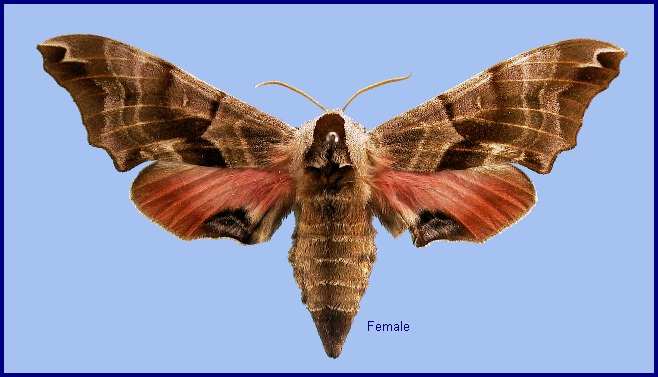
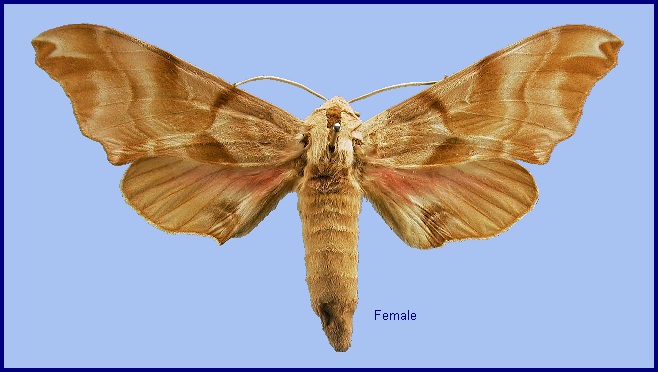
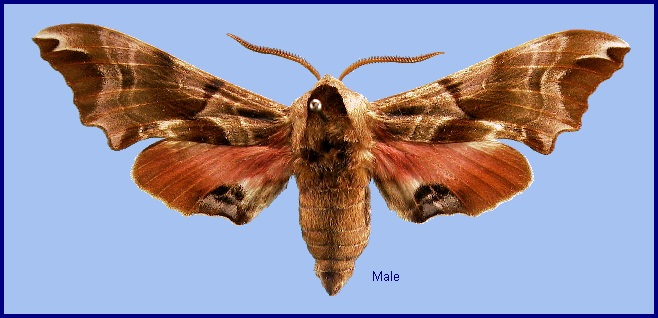

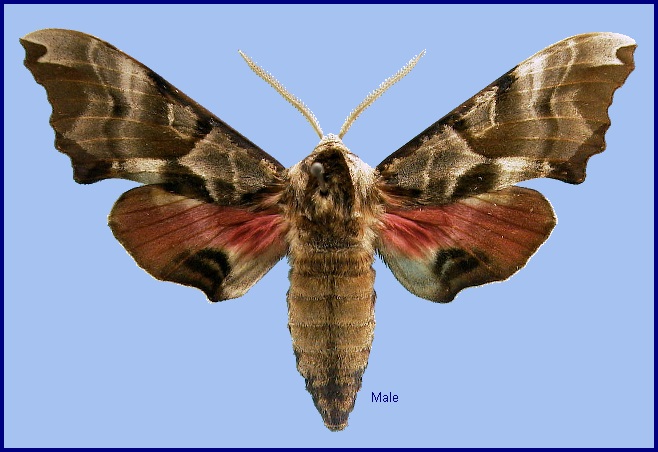
Smerinthus kindermannii Lederer, 1853, Verh. zool.-bot. Ver. Wien (Abhandl.) 2: 92. Type locality: Kurdistan [Turkey], 15 hours west of Diabekir [Diyarbakir], Argana Maden [Maden, north of Ergani].
Synonym. Smerinthus kindermanni var. orbata Grum-Grshimailo, 1890, in Romanoff, Mém. Lépid. 4: 512-513.
Synonym. Smerinthus kindermannii var. obsoleta Staudinger, 1901, in Staudinger & Rebel, Cat. Lepid. Pal. Faunen. 1: 100. Type locality: [China, Xinjiang,] Korla.
Synonym. Smerinthus kindermannii obscura (Closs, 1917).
Homonym. Smerinthus kindermanni meridionalis Gehlen, 1931, Ent. Z., Frankf. a. M. 45: 202.
Synonym. Smerinthus kindermannii gehleni Eitschberger & Lukhtanov, 1996, Atalanta 27: 617.
Synonym. Smerinthus kindermannii iliensis Eitschberger & Lukhtanov, 1996, Atalanta 27: 617.
Note. A fertile female captured in Ürümqi in August 1995 was pale reddish-brown with weak markings (Pittaway & Kitching, 2000). Over the next two years, her offspring varied greatly in coloration and markings, depending upon the temperature and humidity experienced by the developing pupae. Those kept under cool, humid conditions produced dark, well-marked, greyish adults with intense colours, identical to specimens from Turkey. In contrast, pupae exposed to hot, dry conditions produced pale, reddish-brown, poorly marked adults with washed-out colours, like the original female. Such temperature experiments indicate that obsoleta is simply an environmentally induced form of kindermannii, as, in fact, all so-called 'subspecies' of kindermannii appear to be (Kitching & Cadiou, 2000).
Wingspan: 65--80mm. Sexually dimorphic. Similar to Smerinthus ocellata (Linnaeus), but forewing elongate, heavily dentate along the outer margin, with the cryptic pattern more distinct and outlined in light brown or buff. Abdominal segments fringed with white. There is very little variation, except between generations, the first being paler and lighter in colour. Populations from hot, arid areas are also paler than those from cooler and moister regions, and are referable to as f. orbatus.
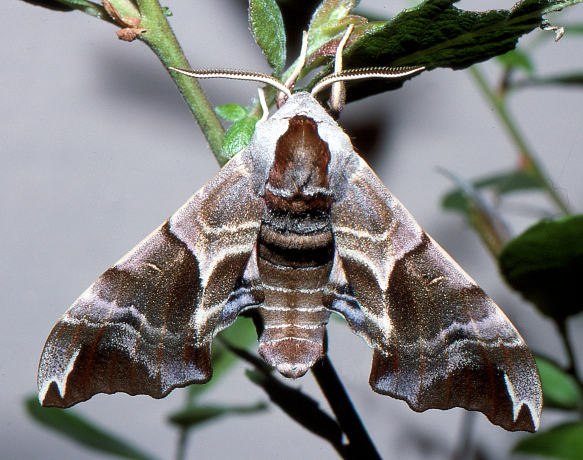
In Xinjiang, there are two generations in most years (May and July/August), but a cold, late spring will result in only one generation, with adults emerging in June. Adult moths generally eclose at dawn. Most females call soon after, with the males flying by day, often as late as mid-morning. The pair remains in copula until dusk. This behaviour may be an adaptation to the very cold nights that can occur in this part of central Asia, even in midsummer. Eggs deposited by Xinjiang females are considerably larger than those laid by Turkish moths, being similar in size those those of Laothoe populi.
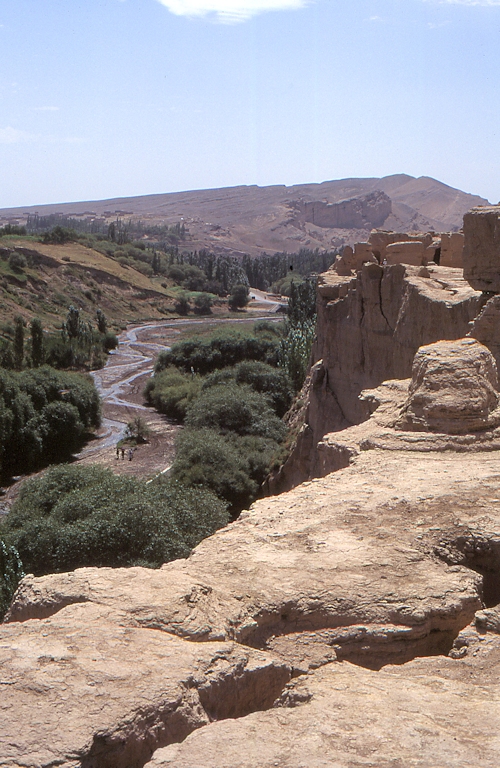
China: 3.v (Zada); 7.v-29.vii (Shihezi); 25.vi (Turpan); 1.viii (ürümqi); 4.viii (Magansi).
Mongolia: 13.vii (Khovd Province).
OVUM: Similar to that of Smerinthus ocellata and laid in similar locations. Those deposited by Xinjiang females (2.0 x 1.5mm) are considerably larger than those laid by Turkish individuals, being similar in size those those of Laothoe populi.
LARVA: Full-fed 54--60mm. Dimorphic: fern-green or bluish grey. In colour and behaviour, very similar to Smerinthus ocellata at all stages; however, of the two colour forms to be found, unlike Smerinthus ocellata, the predominant one is primarily fern-green with yellow oblique side stripes (sometimes edged with red); the other is bluish grey with white markings. When fully grown, shorter and much more slender than Smerinthus ocellata, with a stouter but less erect anal horn.
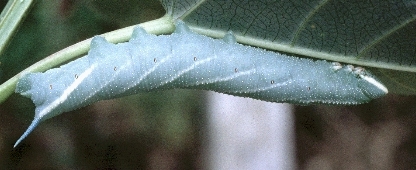
PUPA: 30--37mm. Deep mahogany brown, but otherwise resembling a short, slender Smerinthus ocellata pupa. Pupation occurs at the base of the hostplant or, more often, some distance away under a grass tussock, 2--3cm under the surface of the soil within an earthen cell. The overwintering stage.
Larval hostplants. Unknown in China but elsewhere oligophagous on Populus and Salix.
Unknown.
China: Xinjiang (Magansi; Shihezi; Turpan; Ürümqi; Xiaerxili Natural Reserve, near Bole City, Bortala Mongol Autonomous Prefecture); Ningxia; Gansu; Xizang/Tibet (Zada, 950m).
Mongolia: Khovd Province (30 km NNW Bulgan, River Bulgan and River Bayan, 1500m).
Occurs throughout the central Palaearctic Region (Pittaway, 1993), from Turkey (de Freina, 1979; Ayberk & Akkuzu, 2005; de Freina, 2012; Koçak & Kemal, 2018; Seven, 2020), Cyprus and Lebanon, east through Iraq, Iran, Afghanistan and northern Pakistan (Rafi et al., 2014), to Kashmir (Bell & Scott, 1937; Smetacek & Kitching, 2012; Rafi et al., 2014); Himachal Pradesh (Sidhu, Nair & Kubendran, 2018) and, maybe, Sikkim (Khan & Raina, 2017); thence north and northeast through Turkmenistan, Uzbekistan, Tajikistan, Kyrgyzstan and Kazakhstan, to northwestern China (Xinjiang, Ningxia, Gansu) (Staudinger, 1901; Chu & Wang, 1980b; Danner et al., 1998; Pittaway & Kitching, 2000) and western Mongolia (Yakovlev, Ustyuzhanin & Doroshkin, 2005). Single specimens have been recorded from Israel (Eisenstein, 1984) and Kuwait (Pittaway, 1993). Reports of Smerinthus kindermannii from the Transbaikal area of Russia (Eversmann, 1854; Derzhavets, 1984) are probably misidentifications of the brown form eversmanni (Eversmann) of Callambulyx tatarinovii tatarinovii.
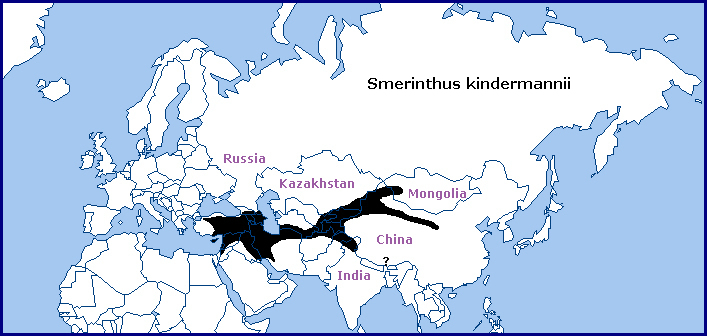
Holarctic; western Palaearctic region. Pleistocene refuge: Polycentric -- Syrian, Iranian and Turkestan refugia.
 Return to Sphingidae of the Eastern Palaearctic species list
Return to Sphingidae of the Eastern Palaearctic species list